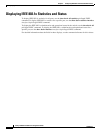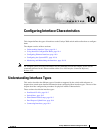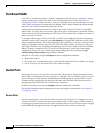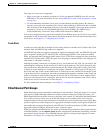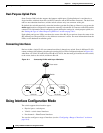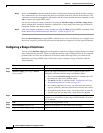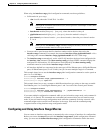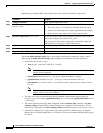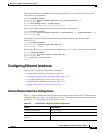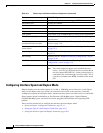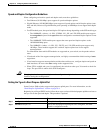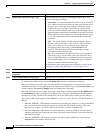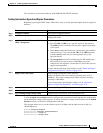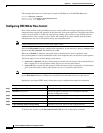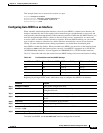
10-8
Catalyst 2960 Switch Software Configuration Guide
78-16881-01
Chapter 10 Configuring Interface Characteristics
Using Interface Configuration Mode
Beginning in privileged EXEC mode, follow these steps to define an interface range macro:
Use the no define interface-range macro_name global configuration command to delete a macro.
When using the define interface-range global configuration command, note these guidelines:
• Valid entries for interface-range:
–
vlan vlan-ID , where the VLAN ID is 1 to 4094
Note Although the command-line interface (CLI) shows options to set multiple VLANs, these
options are not supported.
–
fastethernet module/{first port} - {last port}, where the module is always 0
–
gigabitethernet module/{first port} - {last port}, where the module is always 0
–
port-channel port-channel-number - port-channel-number, where the port-channel-number
is 1 to 6.
Note When you use the interface ranges with port channels, the first and last port-channel
number must be active port channels.
• You must add a space between the first interface number and the hyphen when entering an
interface-range. For example, gigabitethernet0/1 - 4 is a valid range; gigabitethernet0/1-4 is not
a valid range.
• The VLAN interfaces must have been configured with the interface vlan command. The show
running-config privileged EXEC command displays the configured VLAN interfaces. VLAN
interfaces not displayed by the show running-config command cannot be used as interface-ranges.
• All interfaces defined as in a range must be the same type (all Fast Ethernet ports, all Gigabit
Ethernet ports, all EtherChannel ports, or all VLANs), but you can combine multiple interface types
in a macro.
Command Purpose
Step 1
configure terminal Enter global configuration mode.
Step 2
define interface-range macro_name
interface-range
Define the interface-range macro, and save it in NVRAM.
• The macro_name is a 32-character maximum character string.
• A macro can contain up to five comma-separated interface ranges.
• Each interface-range must consist of the same port type.
Step 3
interface range macro macro_name Select the interface range to be configured using the values saved in
the interface-range macro called macro_name.
You can now use the normal configuration commands to apply the
configuration to all interfaces in the defined macro.
Step 4
end Return to privileged EXEC mode.
Step 5
show running-config | include define Show the defined interface range macro configuration.
Step 6
copy running-config startup-config (Optional) Save your entries in the configuration file.



